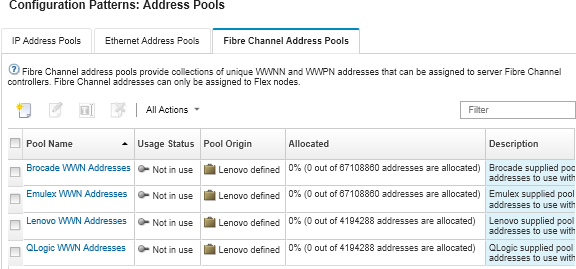Creating a Fibre Channel address pool
Fibre Channel address pools are collections of unique World Wide Node Name (WWNN) and World Wide Port Name (WWPN) addresses that can be assigned to Fibre Channel adapters. You can use or customize predefined address pools as needed, or you can create new pools. When creating server patterns, if you enable virtual addressing for Ethernet adapters, you can choose which Fibre Channel address pool is to be used when the pattern is deployed. When the associated server pattern is deployed, WWNN and WWPN addresses are allocated from the pool and assigned to individual servers.
Procedure
Complete the following steps to create a Fibre Channel address pool.
- From the Lenovo XClarity Administrator menu bar, click . The Configuration Patterns: Address Pools page is displayed.
- Click the Fibre Channel Address Pools tab.
- Click the Create icon (
 ). The Fibre Channel Address Pools dialog is displayed.
). The Fibre Channel Address Pools dialog is displayed. - Enter a name and description for the address pool.
- Add one or more ranges of addresses:
- Click Save.
After you finish
The new Fibre Channel address pool is listed in the Fibre Channel Address Pools table.


From this page, you can perform the following actions on a selected address pool:
- Modify the address pool by clicking the Edit icon (
 ).
). - Delete the address pool by clicking the Delete icon (
 ).
). - View details about the address pool, including a mapping between the virtual addresses and the installed adapter’s ports and reserved virtual addresses, by clicking the pool name in the Pool Name column.
Give documentation feedback